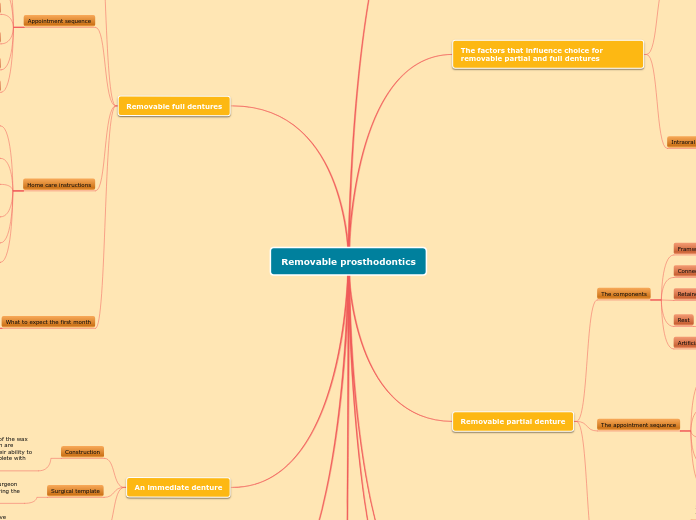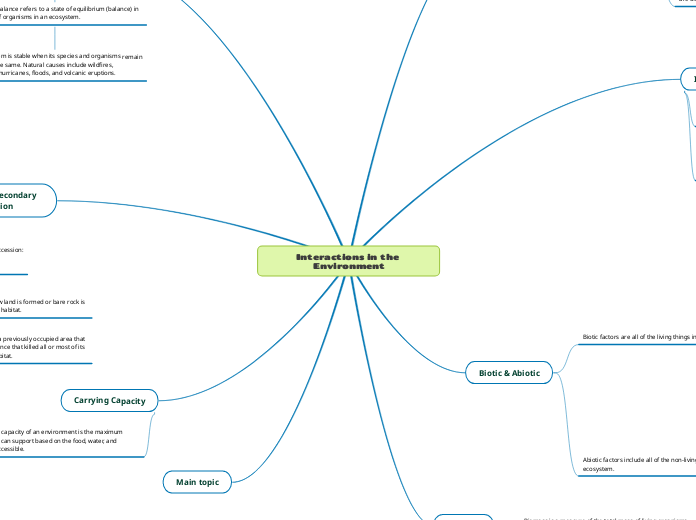Removable prosthodontics
Denture adjustment and relining
Relining
Relining is accomplished by placing a new layer of denture resin over the tissue surface of the appliance. A reline resurfaces the prosthesis, and a rebase replaces the denture base.
Adjustment
If a denture puts too much pressure on a particular area in the mouth, the area will eventually become sore.PIP is used for diagnosing problems with partials and dentures at insertion and adjustment appointments.
The process of constructing overdentures
An overdenture is full denture that is supported by the bony ridge and oral mucosa plus two or more remaining natural teeth or implants.First, the natural teeth are prepared by removing much of their bulk.The remaining tooth structure is protected with a coping.The posts from an implant protrude through the gingiva much like teeth, and a casting is created to fit over the posts.
An immediate denture
Placement
The patient returns in 24 hours for a postoperative checkup.Daily visits continuing until 72 hours after surgery. During each visit, the dentist checks the soft tissue for pressure points.
Surgical template
After the anterior teeth have been extracted, the oral surgeon uses the surgical template as guide for properly contouring the remaining alveolar ridge.
Construction
Before the anterior teeth are extracted, the try-in of the wax setup includes only the posterior teeth. These teeth are aligned in the occlusal rims and are checked for their ability to occlude with the opposing teeth.The denture, complete with anterior teeth, is constructed.
Removable full dentures
What to expect the first month
Day 30-1 month with dentures! Visit dentist on a regular basis
Day 15-29-still learning to talk and eat all over again, the best time to start using an adhesive
Day 2-14-may experience increased salivation, and also experience sore spots from the denture
Day 1-your adjusting to dentures journey is just beginning!
Don' t wear the denture at night
When not in the mouth, store dentures in a moist, airtight container to prevent drying and warping.
Do not soak the denture in hot water or a strong solution such as undiluted bleach, because these liquids will damage the denture
During cleaning, carefully hold the denture over a sink half-filled with cool water.
On removal, thoroughly clean all surfaces of the denture; a special denture brush may be used. Avoid harsh abrasives such as toothpaste
With the denture removed, thoroughly rinse the oral tissues at least once daily
Appointment sequence
Appointment six-postdelivery
Check the mucosa for pressure areas and sore spots
Appointment five-delivery
The denture are delivered to the dental office in a sealed, moist container
Appointment four-try-in
The wax setup consists of the baseplate with the artificial teeth set in wax that resembles gingival tissue
Appointment three-try-in of baseplate and occlusal rim
On the occlusal rims, the dentist records the vertical dimension, occlusal relationship, smile line and canine eminence
Appointment two-final impression
Before the impression is taken, a custom tray is fabricated
Health and dental history, preliminary impression, tray modification and radiographs
Components
Denture teeth are fabricated from acrylic or porcelain and are designed to be retained in the acrylic base of the denture
Post dam
Retention for maxillary and mandibular denture
Flange
Is the part of the base extends over the attached mucosa from the cervical margin of the teeth to the border of the denture
Base
Designed to fit over the residual alveolar ridge and surrounding gingival area
Denture repair and duplication
Duplication
Having a functional denture is important to the patient, and because dentures can break or may require time for relining, the patient can opt to have a duplicate denture.
Repair
A patient may call the office upset because his or her denture or partial has fractured or has a missing or loose tooth.Simple repairs commonly can be fixed in the dental office laboratory. More complicated repairs are sent to the dental laboratory technician for repair.
reference
Bird, D.L., & Robinson, D.S. (2018). Student workbook for Modern dental assisting. St. Louis, MO: Elsevier
Removable partial denture
Home care instructions
Do not adjust the partial denture. The patient should contact the dentist if he ore she has any difficulties
Carefully brush and floss the abutment teeth and the remaining teeth to keep them free of food debris and plaque
After eating, remove the partial denture from the mouth, and brush or rinse the retainers, rests, and complete partial prosthesis
Store the prosthesis in water or in a moist, airtight container when not wearing it
The appointment sequence
Appointment five-postdelivery check
Change
Appointment four-delivery
a 20-30 minute appointment, verify the case has been returned from the lab
Appointment three-try-in
the initial try-in, the appliance consists of the cast frame work and the artificial teeth set in wax
Appointment two-preparation
selecting the shade and mold, preparation of the teeth, taking the final impression ,the bite and occlusal registration and lab prescription
Appointment one-records
updated medical and dental history, prophylaxis, preliminary impressions and radiographs
The components
Artificial teeth
can be constructed from acrylic or porcelain
Rest
is a metal projection designed to control the seating of a prosthesis as it is positioned in the mouth
Retainer
also known as a clasp, is the portion of the framework that directly supports and provides stability to the partial denture
Connectors
or bars, join together the various parts of the partial denture
Framwork
the cast metal skeleton that provides support for the retaining components of the prosthesis
The factors that influence choice for removable partial and full dentures
Intraoral factors
Tori
Can affect the patient's ability to wear a prosthesis in that arch
Oral habits
Clenching and grinding can cause stress on the ridges and remaining teeth; mouth breathing affect the ability to hold
Oral mucosa
When the mucosa is altered by the patients' physical condition ,the prosthesis may cause friction and irritation
Residual alveolar ridge
Successful wearing of a removable prosthesis depends mainly on the support provided by the alveolar ridge
Salivary flow
The presence of a prosthesis in the oral cavity may stimulate an excessive flow of saliva
Musculature
Facial muscle contribute to retention and functional control of the prosthesis
Extraoral factors
Occupation
Social and economic factors
Patients' attitudes about their oral health and appearance will help them decide; the ability to pay for the treatment is important.
Dietary habits
Patients with poor nutritional habits may have poor tissue response to the prosthesis
Age
Patient of different ages have different needs
Patient motivation
Patient's major motive for having removable prosthesis is for esthetic reasons
Mental health
Severe mental disability may not be able to keep the appliance in place
Physical health
Certain chronic medical condition,poor health
Differentiate between a partial and full denture
Full dentures are designed to restored the function and esthetics of the natural dentition when all of the natural teeth are missing.Full denture receives all its support and retention from the underlying tissues, alveolar ridges, hard and soft palate, and surrounding oral mucosa
Replaces all the teeth in one arch
A partial denture receives its support and retention from the underlying tissues and remaining teeth that serve as abutments.It is design to distribute the forces of mastication between the abutment and the supporting tissues.
Replaces one or more teeth in the same arch









